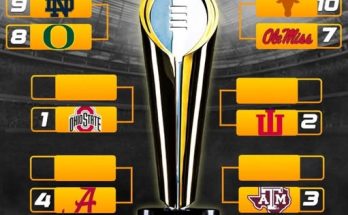Greg Sankey Stealing Texas and Oklahoma Put SEC in Current College Football Playoff Predicament
In the world of college football, few events have sent shockwaves through the sport quite like the announcement that Texas and Oklahoma would be leaving the Big 12 Conference to join the Southeastern Conference (SEC). Spearheaded by SEC Commissioner Greg Sankey, this seismic shift in the landscape of college football seemed like a move that would only benefit the SEC’s already dominant position in the sport. But as the dust has settled and the reality of the changes have unfolded, the SEC now finds itself in an unexpected predicament when it comes to the College Football Playoff (CFP).
What was initially seen as a power grab by one of the most influential conferences in college sports has turned out to have unforeseen consequences. Texas and Oklahoma’s move to the SEC, a decision orchestrated by Greg Sankey and the SEC’s leadership, has complicated the playoff picture in ways that no one anticipated. As we approach the future of the CFP with the expansion of the playoff field, it’s becoming increasingly clear that the SEC’s actions have contributed to the current mess in college football.
Greg Sankey’s Bold Move: A Power Play
When Greg Sankey, who became SEC Commissioner in 2015, made the bold decision to bring Texas and Oklahoma into the SEC, the move was met with mixed reactions. On one hand, it was a monumental win for the SEC, which had already been home to some of the best programs in the country, including Alabama, Georgia, LSU, and Florida. By adding two powerhouse programs like Texas and Oklahoma, Sankey was essentially consolidating even more of college football’s elite talent under one roof.
Sankey’s thinking was simple: the SEC was already the most competitive and influential conference in the nation, so adding Texas and Oklahoma would only strengthen the league’s position both in terms of national championships and TV revenue. With the addition of these two high-profile programs, the SEC would further entrench itself as the gold standard in college football.
On the surface, this seemed like a masterstroke. But as we dive deeper into the aftermath, it becomes evident that the SEC’s decision to add Texas and Oklahoma has created a logistical and competitive nightmare for college football, particularly when it comes to the College Football Playoff.
The College Football Playoff Predicament
Before Texas and Oklahoma’s move to the SEC, the College Football Playoff (CFP) consisted of four teams—teams that were often selected from the power conferences (the SEC, Big Ten, ACC, and Pac-12) and a group of highly ranked teams from smaller conferences. This relatively simple structure worked for the most part, even though there were consistent complaints about the lack of inclusion for teams from outside the Power 5 conferences.
However, the CFP began to show signs of strain as conference realignment continued to reshape college football. With the addition of Texas and Oklahoma to the SEC, the conference now holds even more of the national spotlight. The sheer number of elite programs in the SEC—now home to Alabama, Georgia, LSU, Florida, Texas, and Oklahoma—has resulted in an oversaturated league of top-tier talent. This influx of teams has created a situation where several SEC teams are vying for a spot in the CFP every season, often at the expense of other deserving programs.
The biggest issue here is that the SEC, now with 16 teams after Texas and Oklahoma’s addition, has become a behemoth that dominates the national conversation. The expanded playoff structure will likely see more SEC teams qualifying for the CFP, which in turn will mean fewer spots for other conferences that were once more evenly represented. With so many elite programs in the SEC, it becomes difficult for teams outside of the conference to break through, even if they have a legitimate claim to a playoff spot.
The 2024 and 2025 seasons, which will be the first to incorporate an expanded 12-team playoff format, will be a direct result of this growing imbalance in college football. The new format aims to allow for more inclusion, but with the SEC’s dominance, it’s possible that several deserving teams from other conferences may still find themselves on the outside looking in. For example, if the SEC manages to get five or six teams into the playoff field every year, that leaves little room for teams from the Big Ten, Pac-12, and ACC.
While Greg Sankey’s move to add Texas and Oklahoma to the SEC may have been seen as a strategic power play for his conference, it is now clear that this decision has exacerbated an already complicated situation when it comes to playoff expansion. The SEC is so dominant that it may overshadow the rest of college football, making it harder for teams from other conferences to crack the playoff field.
SEC’s CFP Dominance: Is It a Good Thing?
For fans of SEC schools, this shift may seem like an undeniable victory. More SEC teams in the CFP means more exposure, more TV contracts, and potentially more national championships. But for college football as a whole, this increased dominance could have long-term negative consequences. When one conference, no matter how powerful, is allowed to dictate the majority of playoff spots, the competition begins to suffer.
The SEC’s growing monopoly on the College Football Playoff could lead to several outcomes:
-
Regional Imbalance: The SEC may become so dominant that the rest of college football is left to fight for scraps. Teams from other conferences will have to fight for the remaining few playoff spots, even if they have strong seasons themselves.
-
Stagnation of Other Conferences: As more SEC teams infiltrate the playoff field, teams from other conferences may find themselves at a disadvantage when it comes to recruiting and TV revenue. This could perpetuate a cycle where only the SEC is able to consistently recruit elite talent, while other conferences struggle to keep up.
-
Decreased National Appeal: College football has always been about competition and parity. If the SEC continues to monopolize the playoff field, it could result in a



